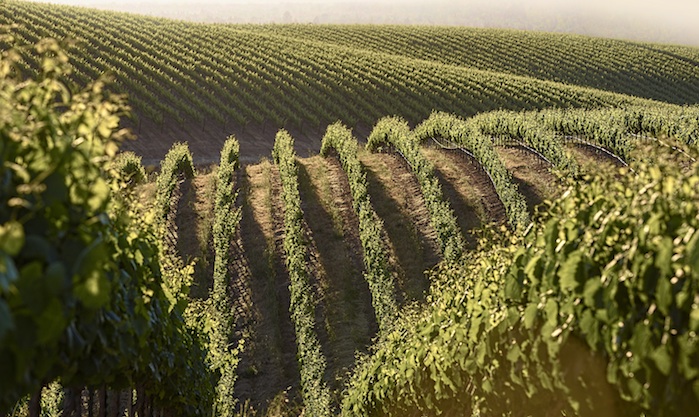One hour east of San Francisco is the historic Livermore Valley AVA. Wines from here have long enjoyed a global recognition. An 1884 vintage from the area’s Cresta Blanca Winery won California’s first wine competition in France during the Exposition Universelle of 1889.

Little has changed. Livermore Valley continues to put out world-class wines, from boutique producers to industry leaders like Wente Vineyards. The latter is America’s oldest continuously operating, family-owned vineyard. And while Wente has grown from 47 acres in 1883 to 2,700 today, the company has stayed true to its roots by allowing its estate vineyards to continue small production.
This includes Murrieta’s Well. Founded in 1884, the Livermore Valley estate vineyard (pictured atop) specializes in terroir-driven, small-batch blends. Mostly recently it released The Whip 2014 — a white blend of 29% Semillon, 27% Chardonnay, 18% Sauvignon Blanc, 12% Orange Muscat, 8% Muscat Canelli and 6% Viognier — and The Spur 2013 — a red blend of 40% Petite Sirah, 26% Cabernet Sauvignon, 10% Petit Verdot, 8% Merlot, 8% Cabernet Franc and 8% Malbec.
 I met with Murrieta’s Well Winemaker Robbie Meyer a few weeks back to discuss his blends and how they reflect Livermore Valley.
I met with Murrieta’s Well Winemaker Robbie Meyer a few weeks back to discuss his blends and how they reflect Livermore Valley.
BD: What defines Livermore Valley?
RM: I’ve worked all over, so when I think about ‘What’s Livermore Valley’, I think about how all great wine regions have simple factors that make them great. We have great maritime influence, with moderate rainfall. We get less rain than Napa or Sonoma.
Across our own estate, which is 500 acres, we have three distinct soil types and huge changes in elevation. The highest elevation is 800 feet, the lowest, 560 feet. And we have this whole area to work with in making our survey blends. Our blends represent Livermore Valley as well as our own blocks.
BD: What is your guiding motivation when making the blends?
RM: The ‘yum factor’. These blends ultimately need to be yummy and delicious. And they need to be highly drinkable.
When I’m at my blending table I need to remember that in each vintage, every varietal expresses itself differently. Each year you have to put together the puzzle differently. A varietal that is 27% of the blend one year might be just 19% the following year.
BD: There can be a tendency among some American drinkers to look down on blends. Have you experienced that?
RM: No, not really, but I can understand where that negative reaction comes from. Typically that’s due to compositions that are ‘kitchen sink’ blends. A winery gets a phone call from ‘Farmer Joe’, who has 14 extra tons of Zinfandel and wants to know if the winery wants to buy it cheap, throw it into a blend and see what happens.
We’re obviously very different than that. We focus only on our own blocks. There’s no ‘throwing together’ for us. There’s an art to blending. We get the most out of our varietals and then blend them.
With The Whip I put in the small percentage of Muscat for the fruit floral notes. The Chardonnay, Viognier and Semillon add weight, while the Sauvignon Blanc is balance for the acidity. That’s the whole puzzle there.
 The Whip has a great aromatic floral expression, and brings texture, weight and substance to the palate. Like a great Sauvignon Blanc it’s dynamic on the palate. The Spur is lively and fresh, approachable with enough structure, drinkable right now, and very food friendly. Blends can accompany a more diverse family of foods.
The Whip has a great aromatic floral expression, and brings texture, weight and substance to the palate. Like a great Sauvignon Blanc it’s dynamic on the palate. The Spur is lively and fresh, approachable with enough structure, drinkable right now, and very food friendly. Blends can accompany a more diverse family of foods.
We release single-varietals as well, but of course they’re more limited. The Petite Syrah in The Spur, for instance, grows really well on our estate. But it can have gaps aromatically and on the palate. In the right blend you can fill in those holes and give it the right edge and really have something great. When I sit down at my blending table, I want to deliver the most that I can to the consumer.
BD: Murrieta’s Well update its packaging this year.
RM: Our old bottles had more of a focus on their names, and some people were missing the point of what was in the bottle. We wanted more of a sense of place on the labels. We want transparency, as it helps to tell our story.
Details: The Whip 2014 (13.5% ABV) launched last December in 6,000 cases for a SRP of $27 per 750-ml. bottle. The Spur 2013 (14.5% ABV) came out in February in 8,000 cases for a SRP of $30 per 750-ml. bottle. Both are available in limited distribution in select markets, including New York, New Jersey, Connecticut, Massachusetts and California.
Kyle Swartz is the associate editor of Beverage Dynamics Magazine. Reach him at kswartz@epgmediallc.com and follow him on Twitter at @kswartzz.




